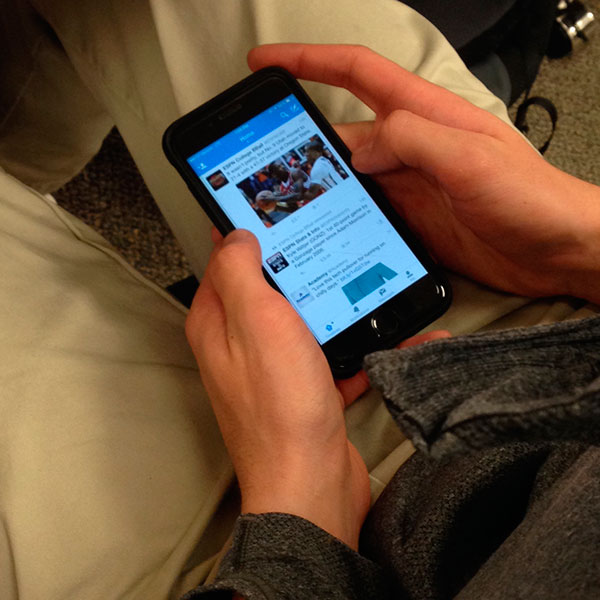Twitter 101

February 20, 2015
“I got a Twitter because of peer pressure. Everyone was getting a Twitter I guess,” said senior Mitchell Fisher (@mitchthefish5).
The social media network, Twitter, has become one of the most popular ways to stay connected and interact with others. And now, more and more teens are finding themselves migrating from Facebook to Twitter. In an email survey of 48 AHS students, more than 60 percent said they had an account with Twitter.
So, with the great migration underway here are some of the basic guidelines for success in the Twitterverse.
Rule #1: When tweeting, air more on the comedic side.
On a network with over 288 million active users and more than 500 million tweets in a day, it is very easy for drama to leak into the Twittersphere. However, it should not be your goal to contribute to this drama when sending out a tweet.
“I’m usually comedy. I don’t do that drama stuff,” said Arapahoe senior and Twitter user Scott Ayers (@SpooningInMay).
The key is being able to make people smile and not scowl when they see your name come across their feed. Believe it or not, that goes a long way. In the same email survey of 48 AHS students, 39 percent said they mainly use Twitter for humorous ends.
“I usually try to make people smile, while also pointing out something that I want them to notice and be aware of,” said senior Ellen Savarese (@followthesun28). “I think if you can your message across in a funny way, people will be more likely to remember it.”
Rule #2: Follower count doesn’t matter.
Followers are the way Twitter measures the popularity of a certain user. The more followers you have, the more popular and louder your voice becomes. High follower counts are usually reserved for people like Ashton Kutcher (16.7 million followers) or President Barack Obama (54.6 million followers).
So, when it comes to being a high school student with a fresh Twitter account, don’t be too concerned with follower count. In a poll of 48 people 63 percent people were indifferent or disagreed with the statement that follower count matters.
“I mean, it’s nice to have a big rise in your followers,” said Ayers. “But at the end of the day that’s not what’s gonna help me do well in the future. It’s just kind of there.”
Rule #3: Don’t be annoying.
When you log on to Twitter, think of it as a giant room of people. Those people are, of course, your followers. And, keeping that analogy in mind, do your best not to annoy everyone in the room. Not only will this cause your follower count to plummet faster than the number of mySpace users, but it will also damage your online reputation.
“Don’t be annoying on Twitter,” said Ayers when asked to impart any wisdom onto rookie tweeters.
This includes, but is not limited to, a disproportionate amount of hashtags after a tweet (a good rule of thumb is 3-4), excessive tweeting (a good cap is roughly 5-6 tweets per day), requesting retweets (one of the seven deadly Twitter sins), and subtweeting (more on that later).
Rule #4: News, entertainment, and humor should be the focus.
Unless you have some serious chops as a tweeter, your focus should be on some combo of news, entertainment, and humor. Follow whoever you wish to follow and as many people as you wish to follow.
“I got Twitter to stay up on news, stay up on sports, and follow a ton of athletes to see what they are doing,” said senior Austin Lienemann (@Stan_A_train). “So, really just for news purposes.”
There is, however, a fine line between informative and overload.
“A recommendation I would make to Twitter newbies is not to follow a whole ton of those really girly/teenager-y accounts,” said Savarese. “One or two is fine but you’ll get tired of them really quickly… I promise.”
Know your information limitation. Twitter can quickly become an exercise in asking for a sip of water from a fire hydrant.
Rule #5: Refrain from subtweeting.
This is perhaps the most despised thing in all of Twitterland.
Subtweeting is the practice of tweeting about someone (more than likely a follower) in a negative light without mentioning them. In essence, it is talking behind someone’s back right in front of them. It is the cop-out of all cop-outs in the social media world.
“I’m not gonna lie, subtweets might be the most annoying thing. Just tell it to them face-to-face alright,” said Ayers. “You are just hiding behind a curtain and you could be hurting someone’s feelings.”
In addition to damaging one’s cyber-reputation, subtweeting has an impact on one’s real world reputation.
“Subtweeting is lame, childish, and should not happen,” said Lienemann.
Subtweeting was the consensus key piece of advice for those just entering the Twitterworld.
“My number one Twitter rule is about subtweets,” said Savarese. “If you don’t remember who your subtweet was about when you read it a month later, you probably shouldn’t have tweeted it.”
Rule #6: Seriously, NO subtweeting.
Not even once.

